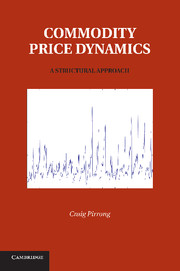Book contents
- Frontmatter
- Contents
- Preface
- 1 Introduction
- 2 The Basics of Storable Commodity Modeling
- 3 High-Frequency Price Dynamics for Continuously Produced Commodities in a Two-Factor Storage Economy: Implications for Derivatives Pricing
- 4 The Empirical Performance of the Two-Factor Storage Model
- 5 Stochastic Fundamental Volatility, Speculation, and Commodity Storage
- 6 The Pricing of Seasonal Commodities
- 7 The Dynamics of Carbon Markets
- 8 The Structural Modeling of Non-Storables: Electricity
- References
- Author Index
- Subject Index
6 - The Pricing of Seasonal Commodities
Published online by Cambridge University Press: 05 June 2012
- Frontmatter
- Contents
- Preface
- 1 Introduction
- 2 The Basics of Storable Commodity Modeling
- 3 High-Frequency Price Dynamics for Continuously Produced Commodities in a Two-Factor Storage Economy: Implications for Derivatives Pricing
- 4 The Empirical Performance of the Two-Factor Storage Model
- 5 Stochastic Fundamental Volatility, Speculation, and Commodity Storage
- 6 The Pricing of Seasonal Commodities
- 7 The Dynamics of Carbon Markets
- 8 The Structural Modeling of Non-Storables: Electricity
- References
- Author Index
- Subject Index
Summary
Introduction
The previous chapters have explored various structural models of continuously produced commodities. This chapter examines a different, important category of commodities: seasonally produced ones, such as corn or soybeans.
These commodities are important in their own right. But, as the results of this chapter demonstrate, an examination of seasonal commodities, and the ability of structural models to explain the high-frequency behavior of their spot and forward prices, points out some serious deficiencies in the storage model.
Specifically, I analyze a two-factor model of a commodity that is produced seasonally. One of the risk factors is the by-now-familiar highly persistent demand shock. The other is an output shock. The commodity is produced once a year, and the size of the harvest is random because of factors such as weather and insect infestations. Moreover, information about the size of the next harvest accumulates throughout the year. I solve the model using the techniques employed throughout the book and then examine particular implications of the model. These implications include the sensitivities of spot prices and futures prices with different expiration dates to demand and harvest shocks, and the correlations between spot and futures prices. I then compare these predictions to the empirical behavior of the spot and futures prices for several important seasonally produced commodities.
- Type
- Chapter
- Information
- Commodity Price DynamicsA Structural Approach, pp. 131 - 163Publisher: Cambridge University PressPrint publication year: 2011

